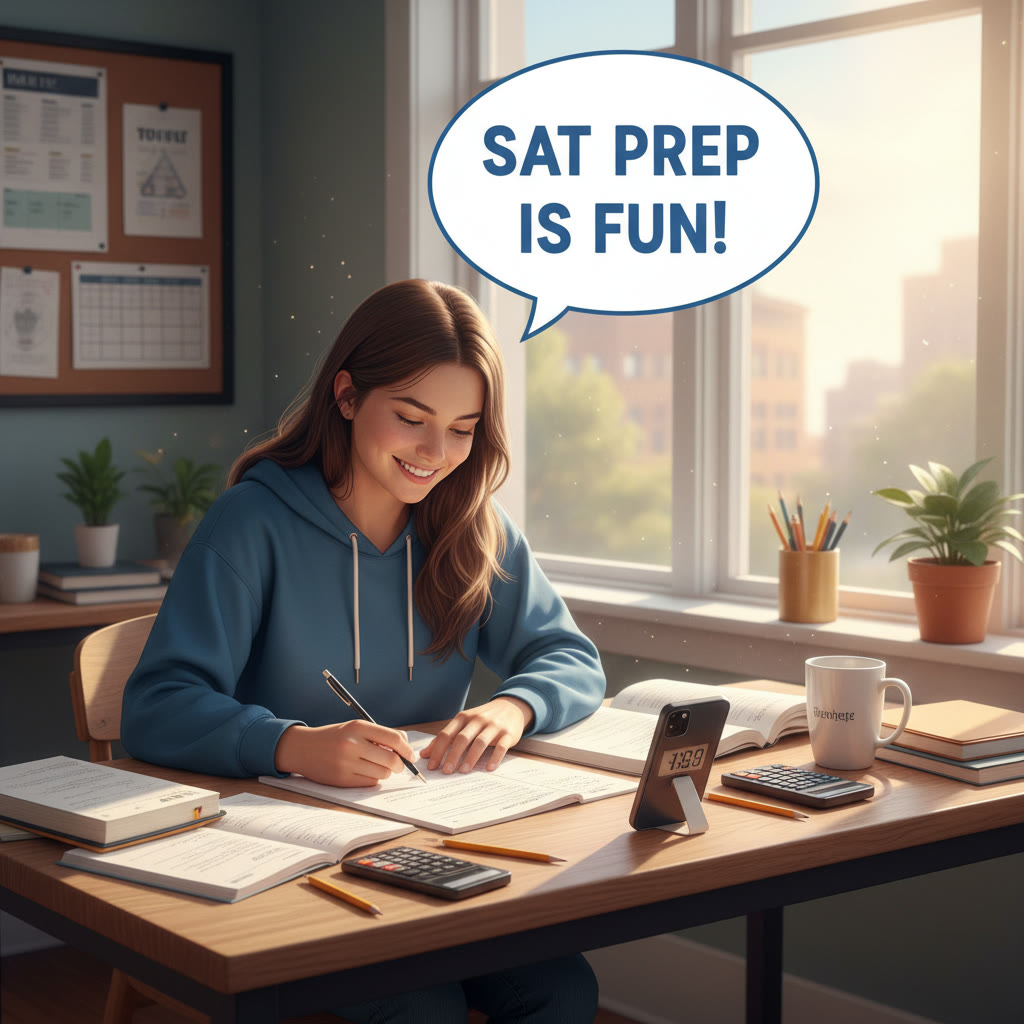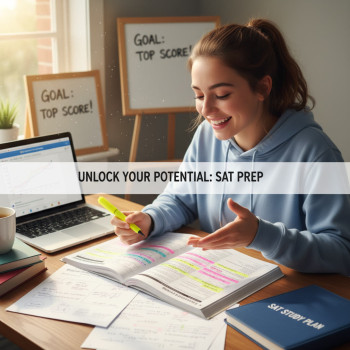How to Prepare for the SAT in 60 Days: A Practical, Energizing Plan
If you have 60 days until test day, you can make dramatic, meaningful progress. It won’t be easy, but with a clear strategy, focused effort, and smart practice, the next two months can turn into a period of steady improvement rather than panic. This guide gives you a realistic roadmap: diagnostic steps, a weekly plan, skill-building techniques for each section, pacing and timing strategies, practice-test routines, and final-day tips. Along the way you’ll see examples, comparisons, and a sample table to help you track progress. If one-on-one guidance sounds appealing, Sparkl’s personalized tutoring and AI-driven insights can be woven into this plan to create customized study blocks and targeted feedback where you need it most.
First things first: mindset and a quick diagnostic
Start by setting a calm, realistic mindset. Sixty days is short, but it’s enough to make focused gains if you concentrate on weakness, not just time spent. Spend the first day taking a true diagnostic: a full-length, timed SAT under realistic conditions. Treat it like a real test—no interruptions, timed sections, and official practice materials if possible. Your diagnostic score is a baseline. From that baseline you’ll identify the three most important targets: the skill with the biggest weakness, the most common type of error you make (timing, careless mistakes, or concept gaps), and a pacing issue if one exists.
How to interpret your diagnostic
- If Reading score lags: look for gaps in passage strategy, vocabulary in context, and time management.
- If Writing and Language is low: focus on grammar rules that appear most often for you—verb tense, subject-verb agreement, punctuation, and sentence structure.
- If Math is your weakest: identify content areas (Algebra, Problem Solving, Advanced Math) and whether errors come from concept gaps or careless calculation mistakes.
Designing the 60-day schedule: weekly and daily structure
The backbone of the plan is consistency: study at least 5 days per week with 1-2 full practice tests every 10–14 days. You want a mix of skill work, targeted practice, and full-length practice tests to build stamina. Here is a simple weekly template that fits most schedules:
- 3 focused content days: deep work on Reading or Writing or Math topics.
- 1 mixed practice day: sets of question practice across sections to simulate switching skills.
- 1 review day: error analysis from previous practice, drilling weak spots.
- Weekend practice test every 10–14 days or a longer practice block to build stamina.
Daily session blueprint (90–150 minutes)
Shorter, higher-quality sessions beat marathon cramming. Aim for 90–150 minutes per day when you can. Here’s a repeatable session format:
- Warm-up (10–15 minutes): quick vocab or grammar drills, or a 10-minute mental math warm-up.
- Focused learning (40–60 minutes): learn or review concepts; break down question types and strategies.
- Targeted practice (30–40 minutes): timed practice sets (e.g., 6 reading questions, 15 math problems).
- Review (15–25 minutes): analyze every mistake—why it happened and what to do next.
Week-by-week roadmap (8 weeks)
Below is a clear eight-week breakdown you can adapt. Each week focuses on specific themes while maintaining mixed practice and review.
| Week | Main Focus | Key Activities | Practice Test |
|---|---|---|---|
| Week 1 (Days 1-7) | Diagnostic and fundamentals | Full diagnostic; basic grammar review; algebra fundamentals; reading strategies | No (diagnostic done) |
| Week 2 (8-14) | Grammar, sentence structure, algebra | Targeted grammar drills; linear equations; timed section practice | No |
| Week 3 (15-21) | Reading comprehension and data interpretation | Passage mapping; evidence-based questions; charts and data sets | Yes (timed, full-length) |
| Week 4 (22-28) | Problem-solving and advanced algebra | Word problems, ratios, functions; calculator vs no-calculator strategies | No |
| Week 5 (29-35) | Essay practice if applicable; integrated review | Practice analysis and synthesis; mixed timed sections | Yes |
| Week 6 (36-42) | Advanced math (quadratics, systems); timing focus | Complex problems, practice pacing, error correction | No |
| Week 7 (43-49) | Full-section simulation and weak-point sprints | Two full-length tests; short, focused drills on the weakest topics | Yes |
| Week 8 (50-60) | Polish, rest, and test-day routines | Light practice, review notes, sleep and nutrition focus | Final practice test early in week; then taper |
That table gives a bird’s-eye view. Now let’s break down specific strategies by section.
Reading Strategies: comprehension, speed, and evidence
Reading comprehension is a combination of active reading, smart question approach, and time management. Here are practical tactics that work under timed pressure.
Passage-first approach vs question-first
Some students skim paragraphs before questions; others jump to questions then look back. Try both during practice to see what suits you. A hybrid method often works best: read the passage actively for structure and tone—annotate the main idea and author stance in the margins—then tackle questions, always looking back for evidence. The SAT rewards evidence-based answers, so trace each answer back to the text.
Annotating efficiently
- Circle or underline thesis statements and topic sentences.
- Note transitions that signal contrast or emphasis (but, however, moreover).
- Summarize paragraphs in 2–3 words in the margin for quick reference.
Time management for Reading
A common split is 12–13 minutes per passage set. If you get stuck on a question, mark it and move on—return if time permits. Accuracy on easier questions first builds confidence and guarantees points.
Writing and Language: grammar rules in context
Writing and Language tests grammar inside passages. Memorize rules but learn them in context so you recognize how they appear in actual questions.
Top grammar themes to master
- Subject-verb agreement and verb tense consistency
- Pronoun clarity and agreement
- Modifiers and sentence structure (avoiding dangling modifiers)
- Punctuation for clarity: commas, colons, and semicolons
- Conciseness and rhetorical skills (choosing clearer, crisper phrasing)
Practice approach
Do targeted grammar drills until rules feel automatic. Then practice them in passage sets so you build the ability to identify the problem quickly. During review, always write a one-sentence rule for each error—this cements memory more than simply marking answers correct or wrong.
Math: strategy, shortcuts, and avoiding traps
Math is the section where targeted practice pays huge dividends. Base your plan on diagnostic results—if algebra appears repeatedly, invest extra hours there. The SAT tests conceptual understanding and clever application more than brute computation.
Key content areas
- Heart of Algebra: linear equations, systems
- Problem Solving and Data Analysis: ratios, percentages, interpreting graphs
- Passport to Advanced Math: quadratics and nonlinear expressions
- Geometry and trigonometry concepts that occasionally appear
Calculator strategies
Know when the calculator helps and when it slows you down. Practice mental set-up and estimation so you can check whether your answer is reasonable. For data-heavy problems, a calculator saves time; for algebraic manipulation, pencil-and-brain often wins.
Practice test and review routine
Full-length practice tests are the engine for improvement. They give you timing practice, stamina training, and a diagnostic for ongoing adjustment. Here’s an effective routine:
- Take the practice test under realistic conditions: timed, uninterrupted, and in a quiet space.
- Immediately after, note how you felt—timing, fatigue, question types that tripped you up.
- On a separate day, spend a full session reviewing every missed question. Don’t skip easy correct answers—sometimes lucky guesses mask shaky reasoning.
- Log mistakes into a running spreadsheet or notebook: question type, error cause, and corrective action.
Sample scoring progress tracker
| Practice Test | Reading | Writing | Math | Total | Notes |
|---|---|---|---|---|---|
| Diagnostic | 470 | 430 | 500 | 1400 | Timing issues in Reading; careless math errors |
| Midpoint (after 4 weeks) | 510 | 460 | 540 | 1510 | Improved pacing; still inconsistent on advanced math |
| Final Practice | 540 | 490 | 570 | 1600 | Solid strategy; focus on last-week light review |
Keep such a table and update it after each full practice test. The numbers above are illustrative—your own trajectory may differ, but tracking progress is essential.
Pacing, timing, and exam-day stamina
Pacing is as important as content knowledge. Practice sections with an internal clock: know how many questions you should average per minute. If a question takes too long, mark it, move on, and return if time permits. Stamina comes from full-length practice: build up to testing for the full duration with only brief breaks like on test day.
Simple pacing targets
- Reading: aim for about 12–13 minutes per passage set (10 questions).
- Writing: roughly 35–40 seconds per question.
- Math (No Calculator): around 1.5 minutes per question; Math (Calculator): about 1.5–2 minutes per question depending on complexity.
Stress, sleep, and nutrition: the overlooked factors
Study is necessary, but rest is equally important. Your brain consolidates learning during sleep. In the final two weeks, prioritize consistent sleep schedules and light exercise to keep stress manageable. On test day, eat a balanced breakfast with protein and complex carbs and stay hydrated. Avoid trying new foods or disruptive routines that morning.
How Sparkl’s personalized tutoring can fit into a 60-day plan
If you want to accelerate progress, targeted guidance helps you avoid common pitfalls. Sparkl’s personalized tutoring offers 1-on-1 guidance, tailored study plans, expert tutors, and AI-driven insights that identify patterns in your mistakes. Imagine spending less time guessing what to study and more time fixing the exact errors that cost you points—Sparkl can help craft short-term sprints for those specific weaknesses and provide feedback after practice tests to tighten your study plan.
Two sample daily schedules
Here are two example days—one for weekdays after school, and one for a weekend focused practice block.
| Time | Weekday (90 minutes) | Weekend Intensive (3.5 hours) |
|---|---|---|
| 0:00-0:15 | Warm-up: vocab/mental math | Warm-up: quick diagnostics and 15-minute review |
| 0:15-1:00 | Focused study: grammar or algebra lesson | Two timed SAT sections back-to-back (Reading + Writing) |
| 1:00-1:30 | Targeted practice: 20 math problems | Review section mistakes and write rules |
| 1:30-1:45 | Review mistakes and write action items | Short break and mental reset |
| 1:45-2:00 | Light reading practice or vocabulary | Advanced math practice (no-calculator) |
Last 7 days: taper, polish, and logistics
The last week should be about consolidation, not new content. Do one to two light practice tests early in the week, then taper off. Focus on quick review notes, commonly missed grammar rules, and mental rehearsal of test day logistics: what to bring, how to get to the test center, and timing. Sleep 7–9 hours each night and avoid intense cramming the day before the test.
Test-day checklist
- Admission ticket and photo ID (as required)
- Approved calculator with fresh batteries
- Several #2 pencils and a clean eraser
- Snack and water for break
- Watch or small clock (if allowed) and a confident, calm mindset

Common pitfalls and how to avoid them
Here are mistakes I see students make again and again—and how to fix them:
- Studying passively: fix this by active review—explain mistakes out loud or write the rule.
- Ignoring weak sections: devote weekly priority blocks to your weakest area.
- Overemphasis on speed before accuracy: learn to get answers right at untimed pace, then add speed.
- Not reviewing mistakes: logging errors and tracking patterns prevents repeating them.
Final encouragement and next steps
Sixty days is enough to move the needle—especially if you study with purpose, measure progress, and treat practice tests as learning experiences instead of score-only events. Build habits: short daily practice, weekly full tests, and consistent review. If you want customized support, Sparkl’s personalized tutoring can help create a tailored plan, offer 1-on-1 guidance, and use AI-driven insights to highlight exactly where your study hours will do the most good. The process will stretch you, but each small improvement compounds into real score gains.
Start with the diagnostic, set a realistic target, and commit to your plan. Keep a log of practice-test scores and error types so you can adapt. With steady effort, thoughtful review, and the right strategies, you can walk into test day confident, rested, and ready to perform.

Quick checklist to begin today
- Take a full-length diagnostic under timed conditions.
- Create your 60-day calendar with weekly themes and practice-test dates.
- Set aside daily study windows and stick to them for at least 5 days a week.
- Log mistakes and review them weekly; adjust the plan after each practice test.
- Consider targeted tutoring for stubborn weaknesses to accelerate improvement.
Good luck—treat these 60 days as an experiment in focused learning. With structure, honest review, and small daily wins, you can reach and even exceed your SAT goals.

















No Comments
Leave a comment Cancel